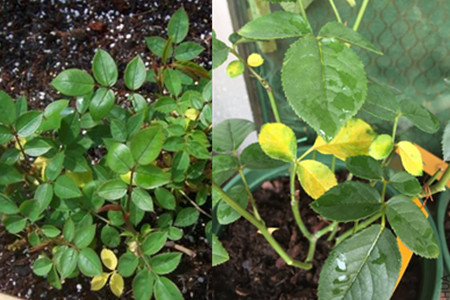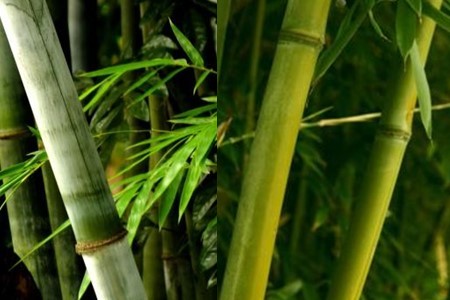The causes of yellow rose leaves, diseases and insect pests are all murderers.

When it comes to rose, friends should be more familiar with it, and the existence of this plant can be seen everywhere. However, this kind of plant is not as easy to feed as we think, even if it is already a very large plant, there may be a variety of situations, one of the more common is that its leaves turn yellow. This symptom is very common, so what are the reasons for it?
1. Too much water is supplied.
This is a more common reason, many friends think that more exposure to water can make it grow more exuberant, but this is not the case. This plant only needs a lot of water when cutting, but it doesn't need so much water after the roots have grown. Therefore, if friends find that their rose has this symptom, it is necessary to reduce the water supply.
2. Germs and bugs are causing trouble.
If friends found this symptom in the plant around May, it could be the cause of germs or bugs. Because at this time the weather begins to get hot, and there is more and more rain, it is very easy to breed germs, and those worms will hatch from the eggs.
3. Not applying enough fertilizer in time
If the leaves begin to turn yellow and the branches of the plant become very slender and listless, it may be that there is not enough fertilizer. At this time, friends need to add some fertilizer to the basin, but they must not bury it directly, but first melt it in the water and then sprinkle it into the basin.
In short, the change in the color of the leaves is probably due to these three, friends must observe carefully, can not let this symptom spread.
Causes, regularity and control techniques of Lycium barbarum insect disaster
Chinese wolfberry is a kind of precious traditional Chinese medicine with high nutritional value. The main diseases of Chinese wolfberry include root rot, brown juice and flower rust, and pests include Chinese wolfberry red gall midge, Chinese wolfberry negative mud worm, Chinese wolfberry wood louse, Chinese wolfberry gall mite and so on. Among the above diseases and insect pests, Chinese wolfberry root rot, wood lice, negative mud insects, gall mites and red gall mosquitoes are common and easy to break out. Next, the editor will introduce the causes, rules and control techniques of the Lycium barbarum pest disaster.
I. the causes of insect infestation
1. The seedlings of planted Lycium barbarum are mixed and of poor quality. because the roots of Lycium barbarum have strong natural germination and more tillers, they have become the main means of propagation of Lycium barbarum. Although this kind of seedlings can maintain the basic characteristics of the mother plant and bear fruit early, but at the same time, it is easy to carry the pathogens of the mother plant, and some seedlings dug up near the diseased plants die in the same year.
two。 In order to see the early benefit, high-density planting is adopted. The cultivation of tree shape is mostly multi-trunk natural shrub shape, although this tree shape has high yield, but the branches are high and dense, it is easy to cause cortex damage of dry branches and brown juice disease under agricultural operation and strong wind. The overdense stand results in poor ventilation and light transmission, and the stand forms a high-temperature and high-humidity environment, which creates favorable conditions for diseases and insect pests.
3. The cultivation of Chinese wolfberry in Jinghe County is relatively concentrated, but farmers operate separately. After the occurrence of diseases and insect pests, there are disagreements in pesticide selection, pesticide application, methods and prevention and treatment period. Resulting in the killing of natural enemies, drug damage and increased drug resistance of insects and other adverse consequences.
Second, occurrence regularity and prevention and control techniques
1. Chinese wolfberry planthopper
Belongs to the same wing ear, wood lice family, also known as pig mouth honey, jaundice, is one of the key pests in the production of Chinese wolfberry.
Occurrence regularity of ①
Lycium barbarum planthopper overwinters as adults in canopy, bark, fallen leaves and withered grass. When the temperature was higher than 5 ℃ in the next year, the sting began to occur. The adults after stinging do not lay eggs before the Chinese wolfberry sprouts, only suck the sap of fruit branches to replenish nutrition, often lie still in the sunny place of the lower branches, and do not move when the weather is cold. Chinese wolfberry began to lay eggs after germination, and the hatched nymphs broke the egg shell from the top of the egg and climbed to the leaves along the egg stalk to do harm. All the nymphs attached to the leaves to suck the leaf juice, and the adults continued to oviposit after Eclosion, which occurred 3-4 generations a year.
② prevention and control technology
Lycium barbarum planthopper overwintered mainly under canopy, under fallen leaves and in litter, and concentrated on removing fallen leaves and withered grass in Lycium barbarum orchard in early March every year, so as to reduce the number of overwintering generations. During the occurrence period, 1.8% Yili lice 5000-6000 times, or 1.8% avermectin 3000 times, or 28% moth lice EC 1500 times could be used for control.
2. Chinese wolfberry rust mite
Occurrence regularity of ①
Lycium barbarum rust mites overwinter as adult mites in the bud eyes of branches. Chinese wolfberry sprouted in the first and middle of April, the adult mites began to sting, migrated to the leaves for harm, spawned in late April, the eggs developed into the original female, and the original female was used for reproduction. Before the rust leaves fall off, the adult mites and nymph mites are transferred to the bud eyes of the branches over the summer. When the temperature dropped to about 10 ℃ in the middle and last ten days of October, the adult mites climbed from the leaf surface to the bud eye of the branch and overwintered.
② prevention and control technology
In the production, the habit of Lycium barbarum rust mites gathering on the fruit branches overwintering, thinning the diseased and residual branches and pruning the fruit branches in the dormant period plays an obvious role in reducing the base number of overwintering rust mites. In the middle and late April, use 50% bromoacarate EC 4000 times or red and white mite rust 2 000 times, and 3 before overwintering in mid-late October. One, five. Stone-sulfur mixture for prevention and control. During the production season, 45% Mel 50% sulfur gel suspension 120-150 times, or 20% amitraz 2 000-3 000 times, or dacarine 2000-2 500 times can be used for prevention and control.
3. Chinese wolfberry gall mite
It belongs to the family gall mites of acaridae. The injured part showed a black nevus gall, and most of the mites lived in the gall. The general control effect is worse than that of rust mite, and the loss caused by rust mite is lighter than that of rust mite.
Occurrence regularity of ①
The mature female Lycium barbarum gall mites overwintered in the overwintering buds, scales and branches of annual and 2-year-old branches of Lycium barbarum. When the branches of Lycium barbarum spread their leaves in the middle and late April of the following year, the adult mites migrated from the overwintering place to the leaves to lay eggs, and the nymph mites drilled into the leaves of Lycium barbarum after hatching to cause galls. In the middle and late May, the new shoots entered the fast-growing stage, and the gall mites on the leaves crawled out of the galls and crawled to the shoots. From then on to the middle of June was the peak period of the first reproductive damage. The second peak of harm was reached in September. It entered the dormant period in the middle and last ten days of October.
② prevention and control technology
Lycium barbarum gall mite and Lycium barbarum rust mite belong to the same family of harmful mites, and the control agents, concentration and time are basically the same as the control of rust mites.
4. Lycium barbarum red gall midge
Lycium barbarum red gall midge is a kind of pest that specially harms the young buds of Lycium barbarum. The young buds harmed by it lose the ability to blossom and bear fruit.
Occurrence regularity of ①
The adults of Lycium barbarum red gall midge come out at dusk and at night, and before 11 o'clock in the day and after 18:00 in the afternoon, the adults only lay eggs on the young buds (buds less than 2 mm), but not on the mature flower buds; after the larvae mature, the larvae climb out of the galls in overcast and rainy weather or under cool night conditions, roll to the surface, and the larvae climb out of the galls and pupate in the soil under the crown. The rain before larva entering the soil, pupation and adult Eclosion is beneficial to its growth and development. The egg stage is about 3-5 days, the larva stage is about 13.4 days, the prepupa stage is about 8.2 days, the pupa stage is about 2.4 days, and the pupa stage is about 26-30 days. The overwintering adults in the normal year will enter the Eclosion stage, and the overwintering adult activity will be found on April 5 in Jinghe. The occurrence of sandy land and sandy soil is serious, and the occurrence of heavy clayey soil is relatively light.
② prevention and control technology
Ground control agents: 40% phoxim emulsion, 2.5-3.0kg phoxim granules per 667m, or 40% chlorpyrifos per 667m 500600ml, or 50% acephate mixed with fine wet soil 60100kg / 667m 500600ml, stuffy 10-12 sJ,H,-J, sprinkled in the garden, sprinkled under the canopy, and irrigated immediately after application. Crown control: according to the development cycle of red gall midge, the control is carried out in the oviposition period of adults. The medicament has 40% chlorpyrifos 700 times solution plus 10% imidacloprid 1 500 times solution, or 40% chlorpyrifos 700 times solution plus 50% acephate 800 times solution, or 30% Alfa 1 000-1 500 times solution.
5. Chinese wolfberry negative mud worm
It generally occurs intermittently or does not occur in the old producing areas, and is a common pest in the newly developed areas of Lycium barbarum, especially in the newly developed areas of the desert. When adults and larvae gnaw on leaves, the control is not timely and even the whole leaves will be eaten up, seriously affecting plant growth and yield.
Occurrence regularity of ①
Lycium barbarum negative mud insects often inhabit wild Chinese wolfberry or weeds, fly to cultivated Chinese wolfberry trees to eat leaf shoots, lay eggs on the back of leaves in "V" shape, and generally hatch into larvae in 8-10 days, and begin to do a lot of harm.
The negative mud worm of Lycium barbarum occurred for 6 generations a year, and the adults overwintered in the field, and the damage was the most serious from June to July. At the beginning of October, the last generation of adults emerged and overwintered at the end of October.
② prevention and control technology
The body wall of Lycium barbarum negative mud worm larva is thin and drug-resistant, so it is relatively easy to control. Generally, poisoning and low-toxic chemical pesticides have good control effect in the larval stage. 40% dimethoate 800 murine pesticide solution, or 20% fenvalerate 2000-2500 times solution, or 2.5% dimethrin 3000 times solution can be used to control the disease, and the effect is very good.
Points for attention in the maintenance of Phoenix wood 1. Temperature
Phoenix wood is a tropical tree species, like high temperature, not cold-resistant, winter no less than 10 degrees Celsius in order to survive the winter smoothly.
two。 Watering
Phoenix trees do not have high requirements for soil, only good drainage, because its roots have rhizobium, can fix nitrogen and increase soil fertility, but stagnant water will make rhizobium die and affect its growth. Therefore, we must grasp the amount of water to ensure that there is no stagnant water.
3. Seedling transplanting and colonization
After 1-2 years of seedling growth, one transplant is needed, and the best transplant should be in early spring. Only when the distance between plants is about 60 cm, 3-year-old seedlings can be used for colonization. After planting, the soil should be loosened every year, weeding 2 or 3 times, and topdressing once in spring and autumn respectively.
4. Pruning
The trunk of Phoenix tree grows new branches and leaves at any time, if it is allowed to grow naturally, the plant shape will change greatly and can not better maintain its vitality, so it needs to be pruned frequently.
Pay attention to and do a good job of the above four points, we can keep the Phoenix tree gorgeous forever, so that everyone who sees it stops for him and marvels at its magnificent beauty! This kind of beauty makes people all over the world deeply love it and regard it as a national tree, a city tree, a city flower and a school flower. Next, the editor will give you a list or two, and you will know that there are so many people all over the world like it!
1. The country that regards it as a national tree: the Republic of Madagascar in Africa
two。 The areas that will be regarded as city trees: Xiamen, Fujian, Tainan, Taiwan, and Panzhihua, Sichuan. (Phoenix trees were once the city trees of Panzhihua City, Sichuan Province, but they were cut down massively because the Phoenix trees broke out seriously for many years in the middle and late 1990s. So the position of the city tree was later replaced by Panzhihua tree)
3. The area that regards it as a city flower: Shantou City, Guangdong Province
4. Universities that regard them as campus beauties: Xiamen University, National Chenggong University
- Prev

How long does the bamboo have long roots and what is the mode of propagation?
There are many varieties of bamboo, belonging to perennial plants of the family Gramineae. Concentrated in the subtropics and tropics, it grows very fast, and some varieties of bamboo shoots are edible. Let's find out how long it takes for its roots to grow.
- Next

What are the reasons for the yellowing and shedding of Milan leaves? how to do a good job of prevention and control?
Milan's flowers are relatively small, the leaves are green and have a charming fragrance. The color and size match between the leaves and flowers are just right, but in the process of maintenance, it is often encountered that its leaves turn yellow and fall off. What is the reason?
Related
- Fuxing push coffee new agricultural production and marketing class: lack of small-scale processing plants
- Jujube rice field leisure farm deep ploughing Yilan for five years to create a space for organic food and play
- Nongyu Farm-A trial of organic papaya for brave women with advanced technology
- Four points for attention in the prevention and control of diseases and insect pests of edible fungi
- How to add nutrient solution to Edible Fungi
- Is there any good way to control edible fungus mites?
- Open Inoculation Technology of Edible Fungi
- Is there any clever way to use fertilizer for edible fungus in winter?
- What agents are used to kill the pathogens of edible fungi in the mushroom shed?
- Rapid drying of Edible Fungi

